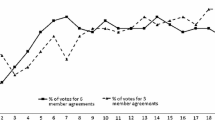Abstract
Several serious environmental problems have a global character. International cooperation to reduce emissions for this type of problems often takes the form of an agreement among the cooperating countries to cut back emissions by a uniform percent rate compared with some base year. This type of agreements has two disadvantages. In the first place, it is well known from environmental economics that equal percentage reductions of emissions from different sources usually gives an inefficient outcome, in the sense that the same environmental goals could be achieved at lower costs through a different distribution of emission reductions. A second problem with agreements of equal percentage reductions is that not all countries will find it in their interest to participate in such agreements. In the paper, it is assumed that the set of countries which participate in an agreement is endogenously determined, with a country participating in an agreement provided that this makes the country better off than it would have been in a situation without any agreement. The agreement among the participating countries is assumed to be a uniform percentage reduction of their emissions. The countries have different opinions about what this uniform percentage should be. In the paper, it is assumed that the outcome is determined by the median country of the participating countries. The assumptions above lead to a particular equilibrium, in which some but not all countries cooperate. The equilibrium reduction of emissions for the cooperating countries is also derived. This equilibrium compared with the first best optimum within the context of simple numerical example.
Similar content being viewed by others
References
Barrett, S. (1989), ‘On the Nature and Significance of International Environmental Agreements’, mimeo, London Business School.
Hoel, M. (1991), ‘Global Environmental Problems: The Effects of Unilateral Actions Taken by One Country’, Journal of Environmental Economics and Management 20, 55–70.
Hoel, M. (1992), ‘Emission Taxes in a Dynamic Game of CO2 Emissions’, in R. Pethig (ed.), Conflict and Cooperation in Managing Environmental Resources, Springer Publishing House.
Mueller, D. C. (1979), Public Choice, Cambridge University Press.
van derPloeg, F. and deZeeuw, A. (1991), ‘International Aspects of Pollution Control’, Environmental and Resource Economics, 2, 117–139, this issue.
Tietenberg, T. (1985), Emission Trading: An Exercise in Reforming Pollution Policy, Resources for the Future, Washington D.C.
Author information
Authors and Affiliations
Rights and permissions
About this article
Cite this article
Hoel, M. International environment conventions: The case of uniform reductions of emissions. Environmental and Resource Economics 2, 141–159 (1992). https://doi.org/10.1007/BF00338240
Issue Date:
DOI: https://doi.org/10.1007/BF00338240



